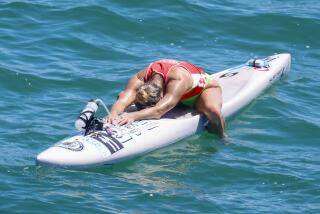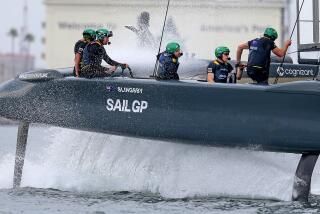COMMENTARY : Decision on Cup Sail Dumping is All Wet
SAN DIEGO â Just when you thought sanity had returned to the Americaâs Cup, comes the news that itâs OK to dump a sail overboard to foul up a rival boat.
Thatâs what Spain did to Sweden, with the blessing of the Louis Vuitton Cup jury.
These are the six men, tried and true, appointed to govern the challenger trials, but they donât seem to be able to get it quite right.
First they ruled that Nippon broke a sail-setting rule in a victory over Il Moro di Venezia, but it was OK because the infringement didnât affect the outcome of the race.
Then they said New Zealandâs controversial bowsprit was OK, but they failed to consult the separate Americaâs Cup match jury, which will preside over Mayâs finals.
Instead, the defenders, hoping to head off trouble in May, checked with the Cup jury and found it to have a different opinion, turning a small issue into another Americaâs Cup embarrassment and forcing the LVC to reverse itself.
However, on Sunday the jury ruled that Challenge Australia could continue to use its new bowsprit as before through the third round, then change before the semifinals.
But that wasnât a very tough decision. Challenge Australia (1-15) wonât be in the semifinals. Nobody would mind if Challenge Australia used an outboard motor at this point.
In the latest fiasco, Espana â92 was leading Tre Kronor by about only three boat lengths Saturday when it bungled a spinnaker drop so badly that it had to cut the sail adrift.
Tre Kronor ran over the sail, caught the sail on its keel and went dead in the water. Espana â92 turned a 12-second lead into 4 1/2 minutes and went on to win easily.
Is that fair?
No.
Is it against the rules?
Well . . . no. And yes.
Bruno Trouble (troo-blay), press officer for the Louis Vuitton company and a veteran racing sailor, said there is no specific rule because âthis is something that never happens. Nobody would cut away a $15,000 sail, except in the Americaâs Cup. They would rather give up the race.â
But there is Fundamental Rule C, the standard, fall-back âFair Sailingâ rule, which is traditionally used when no other rule specifically applies to an incident.
It reads, in part: âA yacht . . . shall compete only by sailing . . . in accordance with recognized principles of fair play and sportsmanship . . .â
So, Sweden protested.
Sorry.
The six-man jury, chaired by Graeme Owens of Australia, decided: âA yacht which cuts loose a sail that has accidentally fallen into the water does not infringe Fundamental Rule C or any other rule. . . .â
So, dumping flotsam overboard to impede an opponent is fair and sporting?
Owens later conceded at a press conference, âI donât think it was fair at all.â
Are we missing something here? Certainly, sailing operates by a unique set of rules, but whatever happened to common sense?
Bob Fisher, a veteran ocean racer and sailing journalist for Englandâs Manchester Guardian, questioned Owens aggressively.
âDo you think itâs quite fair for any boat, then, to ditch its spinnaker in front of another boat and not be penalized at all?â Fisher asked Owens. âBecause youâre now offering that opportunity to everybody else in the Americaâs Cup.â
Owens replied, âI disagree completely.â
And thatâs when he also said, âI donât think it was fair at all.â
Fisher persisted, âDo you think your decision is fair, therefore, in these circumstances? (The incident) does sound to me terribly unfair.â
Owens: âAgain, thereâs a whole series of misstatements there, Bob . . .â
Fisher: âTell me what the misstatements are!â
As Fisherâs voice rose and Owens tried to say something, Trouble, the moderator, broke in, pleading, âBob, Bob . . . this is the first time ever that the jury has come to a press conference to explain (a decision).â
Fisher: âWell, they damn well should as well.â
As order was restored, Owens said, âThe jury is not in position to bend the rules to suit a situation that may be most unfortunate.
âIf the jury found that somebody had deliberately thrown anything in the water to obstruct a trailing yacht, the jury would have the right to throw them out of the event. But in an accidental situation . . . something needing to be cut adrift for safety reasons, that is a completely different situation.â
That reasoning does seem to raise unlimited possibilities for mischief.
Besides Owens, the judges are Don Brooke of New Zealand, Luis Montabetti, China; John Ripard, Malta, and Michael Urwin and Bryan Willis of the United Kingdom.
Brooke did not participate in the bowsprit rulings, for obvious reasons.
Usually, itâs break a rule, youâre out, but for this event the jury was given special latitude--as when it let Nippon off the hook against Il Moro. But it didnât see fit to use that latitude in Swedenâs behalf.
Espana skipper Pedro Campos said, âI sympathize with the Swedish, but we had a similar problem with the French. When we protested, the jury ruled the same way.â
Not quite. Spain was about two minutes behind France in that other incident, giving Franceâs chase boat time to get most of the sail out of the way before Spain arrived.
âPerhaps we need more clear rules for this situation,â Campos said.
Tom Ehman, the Americaâs Cup Organizing Committee executive vice president/general manager, has had differences with the LVC jury, but he agreed with it this time.
âGraeme Owens would have had to invent a new rule to uphold that protest,â said Ehman, himself an international IYRU judge. âItâs one of the breaks of the game . . . a hard-luck situation. I would have ruled the same way.â
But Ehman also conceded, âItâs not right. The rules have got to be fixed.â
More to Read
Go beyond the scoreboard
Get the latest on L.A.'s teams in the daily Sports Report newsletter.
You may occasionally receive promotional content from the Los Angeles Times.










